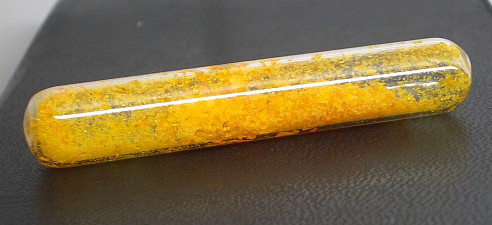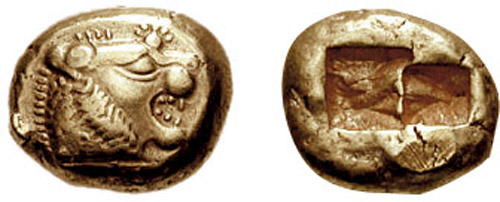|
Miller Process
The Miller process is an industrial-scale chemical procedure used to refine gold to a high degree of purity (99.5%). It was patented by Francis Bowyer Miller in 1867. This chemical process involves blowing chlorine gas through molten, but (slightly) impure, gold. Nearly all metal contaminants react to form chlorides but gold does not at these high temperatures. The other metals volatilize or form a low density slag on top of the molten gold. When all impurities have been removed from the gold (observable by a change in flame color) the gold is removed and processed in the manner required for sale or use. The resulting gold is 99.5% pure, but of lower purity than gold produced by the other common refining method, the Wohlwill process, which produces gold to 99.999% purity. The Wohlwill process is commonly used for producing high-purity gold, such as in electronics work, where exacting standards of purity are required. When highest purity gold is not required, refiners use the M ... [...More Info...] [...Related Items...] OR: [Wikipedia] [Google] [Baidu] |
Gold
Gold is a chemical element with the symbol Au (from la, aurum) and atomic number 79. This makes it one of the higher atomic number elements that occur naturally. It is a bright, slightly orange-yellow, dense, soft, malleable, and ductile metal in a pure form. Chemically, gold is a transition metal and a group 11 element. It is one of the least reactive chemical elements and is solid under standard conditions. Gold often occurs in free elemental ( native state), as nuggets or grains, in rocks, veins, and alluvial deposits. It occurs in a solid solution series with the native element silver (as electrum), naturally alloyed with other metals like copper and palladium, and mineral inclusions such as within pyrite. Less commonly, it occurs in minerals as gold compounds, often with tellurium ( gold tellurides). Gold is resistant to most acids, though it does dissolve in aqua regia (a mixture of nitric acid and hydrochloric acid), forming a soluble tetrachloroaurate an ... [...More Info...] [...Related Items...] OR: [Wikipedia] [Google] [Baidu] |
Chlorine
Chlorine is a chemical element with the symbol Cl and atomic number 17. The second-lightest of the halogens, it appears between fluorine and bromine in the periodic table and its properties are mostly intermediate between them. Chlorine is a yellow-green gas at room temperature. It is an extremely reactive element and a strong oxidising agent: among the elements, it has the highest electron affinity and the third-highest electronegativity on the revised Pauling scale, behind only oxygen and fluorine. Chlorine played an important role in the experiments conducted by medieval alchemists, which commonly involved the heating of chloride salts like ammonium chloride ( sal ammoniac) and sodium chloride (common salt), producing various chemical substances containing chlorine such as hydrogen chloride, mercury(II) chloride (corrosive sublimate), and hydrochloric acid (in the form of ). However, the nature of free chlorine gas as a separate substance was only recognised aroun ... [...More Info...] [...Related Items...] OR: [Wikipedia] [Google] [Baidu] |
Chloride
The chloride ion is the anion (negatively charged ion) Cl−. It is formed when the element chlorine (a halogen) gains an electron or when a compound such as hydrogen chloride is dissolved in water or other polar solvents. Chloride salts such as sodium chloride are often very soluble in water.Green, John, and Sadru Damji. "Chapter 3." ''Chemistry''. Camberwell, Vic.: IBID, 2001. Print. It is an essential electrolyte located in all body fluids responsible for maintaining acid/base balance, transmitting nerve impulses and regulating liquid flow in and out of cells. Less frequently, the word ''chloride'' may also form part of the "common" name of chemical compounds in which one or more chlorine atoms are covalently bonded. For example, methyl chloride, with the standard name chloromethane (see IUPAC books) is an organic compound with a covalent C−Cl bond in which the chlorine is not an anion. Electronic properties A chloride ion (diameter 167 pm) is much lar ... [...More Info...] [...Related Items...] OR: [Wikipedia] [Google] [Baidu] |
Wohlwill Process
The Wohlwill process is an industrial-scale chemical procedure used to refine gold to the highest degree of purity (99.999%). The process was invented in 1874 by Emil Wohlwill. This electrochemical process involves using a cast gold ingot, often called a Doré bar, of 95%+ gold to serve as an anode. Lower percentages of gold in the anode will interfere with the reaction, especially when the contaminating metal is silver or one of the platinum group elements. The cathodes for this reaction are small sheets of pure (24k) gold sheeting or stainless steel. Current is applied to the system, and electricity travels through the electrolyte of chloroauric acid. Gold and other metals are dissolved at the anode, and pure gold (coming through the chloroauric acid by ion transfer) is plated onto the gold cathode. When the anode is dissolved, the cathode is removed and melted or otherwise processed in the manner required for sale or use. The resulting gold is 99.999% pure, and of higher purity ... [...More Info...] [...Related Items...] OR: [Wikipedia] [Google] [Baidu] |
Chloroauric Acid
Chloroauric acid is an inorganic compound with the chemical formula . It forms hydrates . Both the trihydrate and tetrahydrate are known. Both are orange-yellow solids consisting of the planar anion. Often chloroauric acid is handled as a solution, such as those obtained by dissolution of gold in aqua regia. These solutions can be converted to other gold complexes or reduced to metallic gold or gold nanoparticles. Properties Structure The tetrahydrate crystallizes as and two water molecules. The oxidation state of gold in and anion is +3. The salts of (tetrachloroauric(III) acid) are tetrachloroaurates(III), containing anions (tetrachloroaurate(III) anions), which have square planar molecular geometry. The Au–Cl distances are around 2.28 Å. Other d8 complexes adopt similar structures, e.g. tetrachloroplatinate(II) . Solute properties Solid chloroauric acid is a hydrophilic ( ionic) protic solute. It is soluble in water and other oxygen-containing solvents, ... [...More Info...] [...Related Items...] OR: [Wikipedia] [Google] [Baidu] |
Electrolyte
An electrolyte is a medium containing ions that is electrically conducting through the movement of those ions, but not conducting electrons. This includes most soluble salts, acids, and bases dissolved in a polar solvent, such as water. Upon dissolving, the substance separates into cations and anions, which disperse uniformly throughout the solvent. Solid-state electrolytes also exist. In medicine and sometimes in chemistry, the term electrolyte refers to the substance that is dissolved. Electrically, such a solution is neutral. If an electric potential is applied to such a solution, the cations of the solution are drawn to the electrode that has an abundance of electrons, while the anions are drawn to the electrode that has a deficit of electrons. The movement of anions and cations in opposite directions within the solution amounts to a current. Some gases, such as hydrogen chloride (HCl), under conditions of high temperature or low pressure can also function as electrolytes ... [...More Info...] [...Related Items...] OR: [Wikipedia] [Google] [Baidu] |
Gold Parting
Gold parting is the separating of gold from silver (and other metallic impurities). Gold and silver are often extracted from the same ores and are chemically similar and therefore difficult to separate. The alloy of gold and silver is called electrum. Contemporary technology Two technologies are dominant. They both start with relatively pure gold. *The Miller process affords gold up to 99.5% purity. The process involves blowing a stream of chlorine through molten gold. Impurities in the gold form chlorides, which form a slag that floats on the molten gold. *Invented by Emil Wohlwill in 1874, the Wohlwill process produces the highest purity gold (99.999%). It is an electrolytic process using pure gold for the cathode (or titanium as a starter cathode) and chloroauric acid (gold chloride-hydrochloric acid) as the electrolyte; this is made by dissolving gold with chlorine gas in the presence of hydrochloric acid. Gold is dissolved at the anode, and pure gold, traveling through th ... [...More Info...] [...Related Items...] OR: [Wikipedia] [Google] [Baidu] |
Metallurgical Processes
Metallurgy is a domain of materials science and engineering that studies the physical and chemical behavior of metallic elements, their inter-metallic compounds, and their mixtures, which are known as alloys. Metallurgy encompasses both the science and the technology of metals; that is, the way in which science is applied to the production of metals, and the engineering of metal components used in products for both consumers and manufacturers. Metallurgy is distinct from the craft of metalworking. Metalworking relies on metallurgy in a similar manner to how medicine relies on medical science for technical advancement. A specialist practitioner of metallurgy is known as a metallurgist. The science of metallurgy is further subdivided into two broad categories: chemical metallurgy and physical metallurgy. Chemical metallurgy is chiefly concerned with the reduction and oxidation of metals, and the chemical performance of metals. Subjects of study in chemical metallurgy include mi ... [...More Info...] [...Related Items...] OR: [Wikipedia] [Google] [Baidu] |






